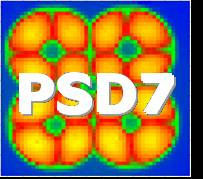Speaker
Mr
Hugo Natal da Luz
(University of Coimbra)
Description
MicroHole and Strip Plate detector (MHSP) has an intrinsic
capability for position detection. This new gaseous multiplier conceived as a
combination of an MSGC and GEM in a single, double sided element, integrates two
successive independent stages of charge amplification, a GEM-like hole-avalanche
and an MSGC-like anode-strip avalanche. Like the GEM, the MHSP
is fabricated with printed circuit board (PCB) technology from a 50-µm Kapton film,
metallized with 5-µm-thick copper-layers on both sides. On the top-side, a GEM-
like pattern of holes is etched through, where on the bottom side a standard
microstrip pattern is etched, with the holes centred on the cathode strips and the
anodes running between them.
The MHSP achieve gains higher than 10^4, and a ratio between top and anode signal
of about 0.3, allowing measuring the charge signal produced on both sides with good
efficiency. The first implementation of a position sensitive readout for this new
detector is described and tested. The readout consists of a resistive layer
crossing the anodes and connected to a preamplifier, on each side. By weighing
the charge pulses on both preamplifiers it is possible to determine the interaction
point. The second coordinate is attained by structuring the top side of the
MHSP with individual strips and using a resistive layer orthogonal to the strips. A
100-ohm resistance layer between consecutive strips was found to be the best
compromise between position linearity and energy resolution.
Preliminary results using 22-keV x-rays presents a good linear trend between the
measured and the actual position, with a deviation of about 0.8 mm. The
performance of the MHSP position detector will be presented and discussed for 1D
and 2D readout.
References, e.g.
[1]-A proposed new microstructure for gas radiation detectors: the Micro-Hole-and-
Strip Plate, J.F.C.A. Veloso, J.M.F. dos Santos e C.A.N. Conde, Review of
Scientific Instruments, Vol. 71, 6(2000)2371-2376.
[2]- Progress in MHSP gaseous electron multiplier operation, J.M. Maia, D. Mörmann,
A. Breskin, R. Chechik, JFCA Veloso, JMF Dos Santos, IEEE Transactions on Nuclear
Science Ns-51 (2004)1503-1508.
Primary author
Mr
Hugo Natal da Luz
(University of Coimbra)
